Through the Years

1861: Benjamin Bloomingdale and his elder son, Lyman, open Bloomingdale’s Hoopskirt and Ladies’ Notion Shop on the Lower East Side.
April 17, 1872: Brothers Lyman and Joseph Bloomingdale open “Bloomingdale’s Great East Side Bazaar” dry goods store at 938 Third Avenue, between 56th and 57th Streets. First-day sales: $3.68. Lyman and his wife Hattie live above the store where their two eldest sons Samuel and Hiram are born. In 1876, the family moves to larger quarters on Beekman Place.
More from WWD
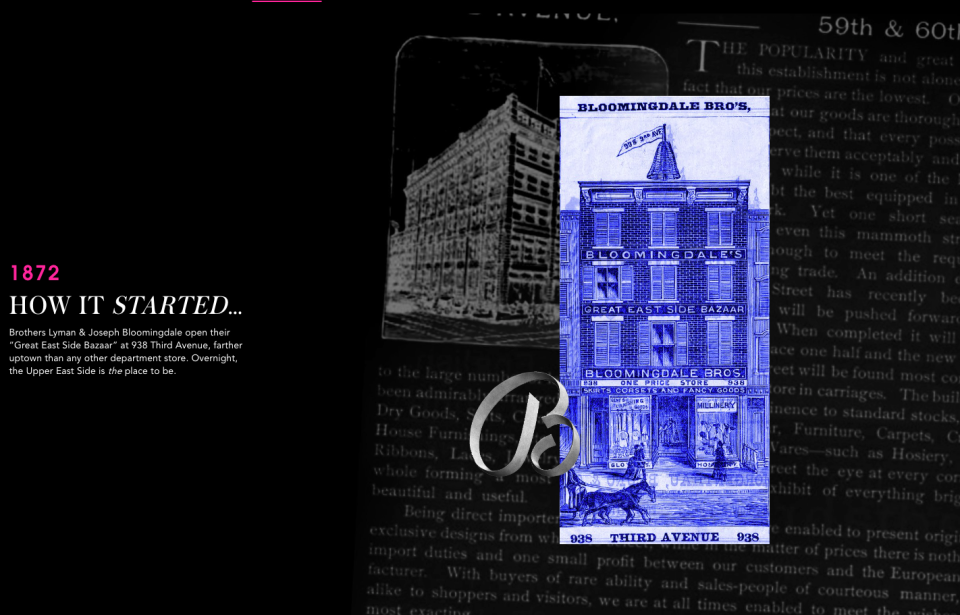
July 5, 1877: The store relocates a few doors south to 924, 926 and 928 Third Avenue.
1880: The brothers purchased a five-story building at the southwest corner of 56th Street and Third Avenue, turning Bloomingdale’s into a department store.
Oct. 5, 1886: The new Bloomingdale Bros. opens on 59th Street and Third Avenue, with six stories, 100 feet of Third Avenue frontage and 145 feet along 59th Street. Two cable-operated elevators, or “sky carriages,” get installed, drawing more people to the store.
April 1886: First foreign trade representative, Sam Meyers, goes to Europe with Edward C. Blum, a trimmings importer, to establish trade with Europe. Within a few years, offices are established in Paris, Berlin, Vienna and other cities.
Jan. 1, 1896: Joseph Bloomingdale retires.
1898: The first of Jesse W. Reno’s patented escalators, called “inclined elevators,” get installed. Reno’s primary financier was Lyman Bloomingdale.
1902: After some expansion, Bloomingdale’s occupies 80 percent of the square block between Third and Lexington Avenues and 59th to 60th Streets.
Oct. 13, 1905: Lyman Bloomingdale passes away. His sons Hiram and Samuel take over.
March 30, 1909: The Queensboro Bridge (now called the Ed Koch Queensboro Bridge) connecting Manhattan and Queens, which both Lyman and Samuel lobbied for, opens. Bloomingdale’s celebrates by publishing a souvenir book.
1916-17: Bloomingdale’s renovates with an updated arcade and entrance on Lexington, helping to draw customers coming off the new Lexington Avenue subway, opened July 17, 1918.
1917-19: With the U.S. in WWI, Samuel donates an entire floor for the Red Cross Headquarters, run by actress Eleanor Robson Belmont.
July 1923: To commemorate the store’s 50th anniversary, Samuel has a replica of the grand staircase in Florence’s Bargello constructed in travertine and Italian mosaic, designed by architect Elisha Harris Janes.
March 19, 1926: Bloomingdale’s lists on the stock market.
1927: Samuel purchases the last of the 62 parcels making up their city block, bringing Bloomingdale’s to 84,000 square feet. Simultaneously, a two-block long warehouse, delivery station, garage and manufacturing plant gets built in Long Island City.
November 1929: Federated Department Stores incorporates, bringing Abraham & Straus in Brooklyn, New York, Filene’s in Boston, Massachusetts and Lazarus of Columbus, Ohio, under one umbrella corporation.
February 1930: Bloomingdale’s joins Federated and each department store changes a majority of its stock for newly created Federated shares. Samuel Bloomingdale steps down as president to become chairman, and Hiram becomes vice president. The merger helps all four stores survive the Great Depression; Bloomingdale’s remains profitable.
1931: Bloomingdale’s finishes construction of a Lexington Avenue Art Deco style building designed by Starrett and Van Vleck to link better with the other Bloomingdale’s buildings that fill the block.
1931: Michael Schapp, president of Bloomingdale’s, rallies 2,500 employees to contribute to the Emergency Unemployment Relief Committee to help the Depression-era unemployed and places ads urging public contributions, building Bloomingdale’s reputation for charity.
March 17, 1931: Bloomingdale’s establishes the Green Room on the third floor, selling copies of French couture women’s fashion by Chanel, Molyneux, Patou and Lyolene.
Jan. 4 to 9, 1932: Bloomingdale’s holds its first annual dog show; the Marx Brothers award the prizes and dog shows continue until 1942.
1937: Bloomingdale’s sales clerks, shelf stockers and clerical workers vote to unionize and join Local 3 of the Retail, Wholesale and Department Store Union.
1943: James S. Schoff becomes president; Michael Schapp becomes chairman.
1947: Schoff assembles an executive team that includes Laurence Lachman as treasurer (later chairman), and J. Edward Davidson as chairman, that proceeds to change Bloomingdale’s from a mass retailer to an upscale one.
Feb. 13, 1947: “A Woman of Fashion, 1947,” a collection of 26 looks created by American designers, Claire McCardell, Adele Simpson and Pauline Trigère among them, show fashion’s way forward after war-time restrictions, and advances Bloomingdale’s fashion reputation in high fashion. The looks are donated to the Costume Institute of the Metropolitan Museum of Art.
Dec. 11, 1947: Bloomingdale’s takes over a Ware’s department store in New Rochelle, New York, establishing the retailer’s first branch. The Ware’s name is maintained for several years, though both names appear on ads and key employees were shared. Ultimately, the name changed to Bloomingdale’s, but management finds taking over another department store is not successful and decides to focus on custom-built locations.
May 24, 1949: The first custom-built Bloomingdale’s branch opens in Fresh Meadows, New York. Twenty-five thousand people visit the first day. Decades later, the site closes.
Late 1940s/early 1950s: Several future stars in the organization including Marvin Traub (1950), Carl Levine (1956) and Barbara d’Arcy (1952) join the company.
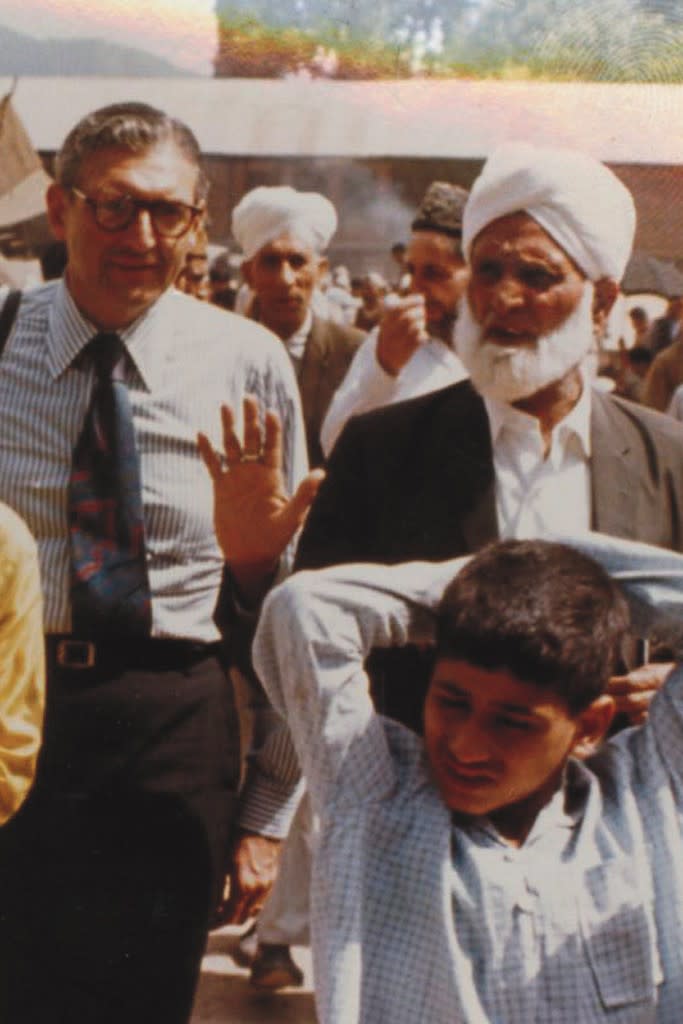
March 15, 1953: Hiram Bloomingdale, former vice president of Bloomingdale Bros., dies.
Feb. 17, 1954: Bloomingdale’s opens a 200,000-square-foot branch in Stamford, Connecticut.
Sept. 12, 1955: The 59th Street flagship stages half-hour all-American fashion shows at lunchtime to appeal to working women, who were encouraged to open “career-girl credit accounts.”
Late 1957: Henriette Granville, fashion coordinator for home furnishings, retires. Barbara d’Arcy is promoted to fashion coordinator.
Sept. 21, 1960: “Casa Bella” features furniture and home goods from Italy, becoming the first of many Bloomingdale’s import fairs staged over the years showcasing exotic merchandise from countries and regions around the world.
Sept. 26, 1961: “L’Esprit de France,” an import promotion of French haute couture, home, fragrance and specialty foods opens with a party for 850 guests; the special shopping bag depicting an old French tarot card, with the store’s name omitted, becomes a fad.
Sept. 23, 1964: The “Johnny’s So Long at the Fair” ties in with the 1964 World’s Fair in Queens, and fills all five of the flagship’s selling floors.
April 1, 1965: Bloomingdale’s employees strike for 15 days, but executives, their relatives and friends operate the store. Demands for a higher minimum wage, a larger pay increase, improved sick leaves and other benefits, were mostly met.
Fall 1966: Harold Krensky returns to Bloomingdale’s to become chairman and managing director. He sets out to make Bloomingdale’s as important for innovative fashion as home furnishings.
February 1967: The 20-year-old Downstairs Store bargain-basement format closes, furthering Bloomingdale’s upscale image.
Oct. 3, 1967: “All the World Is a Stage” import fair revolves around show business and features areas modeled after the theater and cinema.
May 10, 1968: Samuel Bloomingdale dies.
1969: Harold Krensky leaves Bloomingdale’s for Federated; Lawrence Lachman becomes chairman. Marvin Traub becomes president and remains general merchandise manager.
June 1969: Eight months after Halston starts designing clothes, Bloomingdale’s opens a Halston boutique. Previously, Halston was head milliner at Bergdorf Goodman for 10 years.
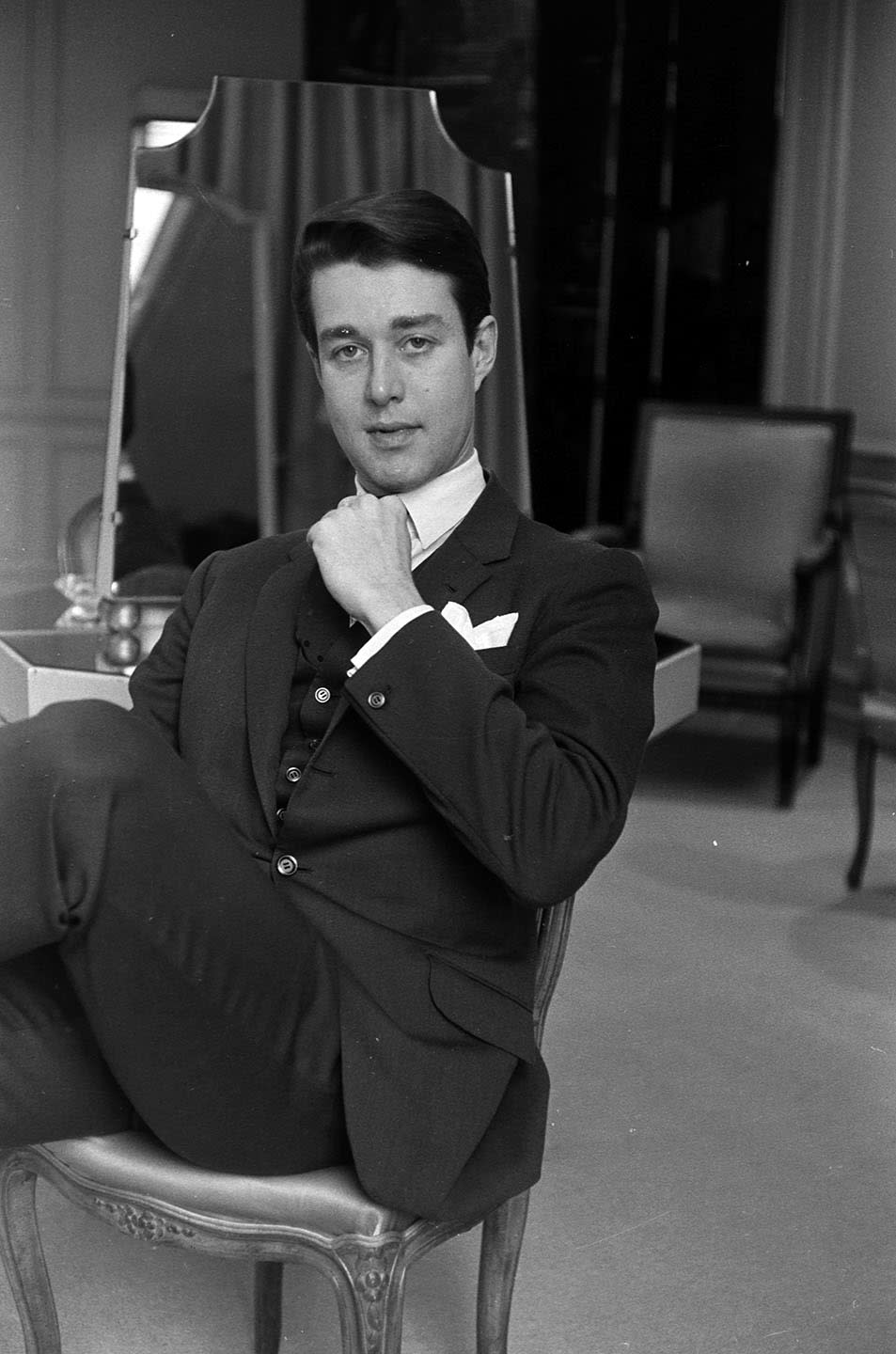
Fall 1969: A Polo Ralph Lauren boutique opens on Bloomingdale’s men’s floor.
January 1970: The Paradox shops opens on the third floor with unusual knits from France, Italy and Scandinavia. It soon becomes a destination for the newest, most avant-garde fashions.
Sept. 22, 1970: “The Creators,” the 10th annual fair, features 19 model rooms designed by Barbara D’Arcy and David Eugene Bell inspired by “the taste, personalities and whims of such culture-creators as Fran?oise Sagan, Anne Klein and Peter Max.”
1971: Mary Joan Glynn becomes vice president of communications, transforming the store’s publicity and advertising and originating the “Saturday’s Generations” concept first for advertising; later it defines a segment of Bloomingdale’s clientele. A “Saturday’s Generation” shop opens in 1974.
Nov. 11, 1971: Weeks after the U.N. recognizes the People’s Republic of China, Bloomingdale’s opens a “China Passage” boutique, becoming the first American store to sell goods from the PRC.
Summer 1971: The third floor expands and renovates to focus on better, experimental and designer labels. Yves Saint Laurent Rive Gauche boutique eventually added.
Sept. 8, 1971: Bloomingdale’s opens its first separate home furnishings store in Manhasset, New York.
1972: Mary Joan Glynn hires designer Massimo Vignelli to create a new logo, typeface and packaging in conjunction with the 100th anniversary celebration.
Oct. 3, 1972: Bloomingdale’s celebrates its centennial with a five-course banquet and dancing for 1,300 guests.
1973: Mary Joan Glynn invents the iconic “big brown bag.” The “little brown bag” arrives a year later.
Feb. 21, 1973: Bloomingdale’s holds a Missoni fashion show, launching the Friends of Spoleto charity, supporting the Italian music festival and marking the first full-scale showing of Missoni in the U.S. More than $4,000 of Missoni knits sells in an hour.
Sept. 12, 1974: Bloomingdale’s 59th Street launches Forty Carrots serving health food; its yogurt becomes a popular favorite. Forty Carrots rolls out over time to most branches.
April 1975: Cathy Cash (Glynn’s successor) hires Michaele Vollbracht as in-house illustrator, from Henri Bendel. He designs the store’s famous Face Bag for fall 1975. Vollbracht later designs his own line.
Sept. 17, 1975: Bloomingdale’s opens its biggest branch to date, a 260,000-square-foot unit in White Plains, New York.
July 4, 1976: Bloomingdale’s celebrates the Bicentennial with special merchandise, events and windows created by Candy Pratts.
July 9, 1976: Queen Elizabeth II and Prince Philip tour Bloomingdale’s including specially designed Model Rooms, the china department where the Queen is presented a Sioux peace pipe, and an “American Classics” section with designs by Calvin Klein, Ralph Lauren and Donna Karan and Louis Dell‘Olio of Anne Klein, which are presented to the Queen.
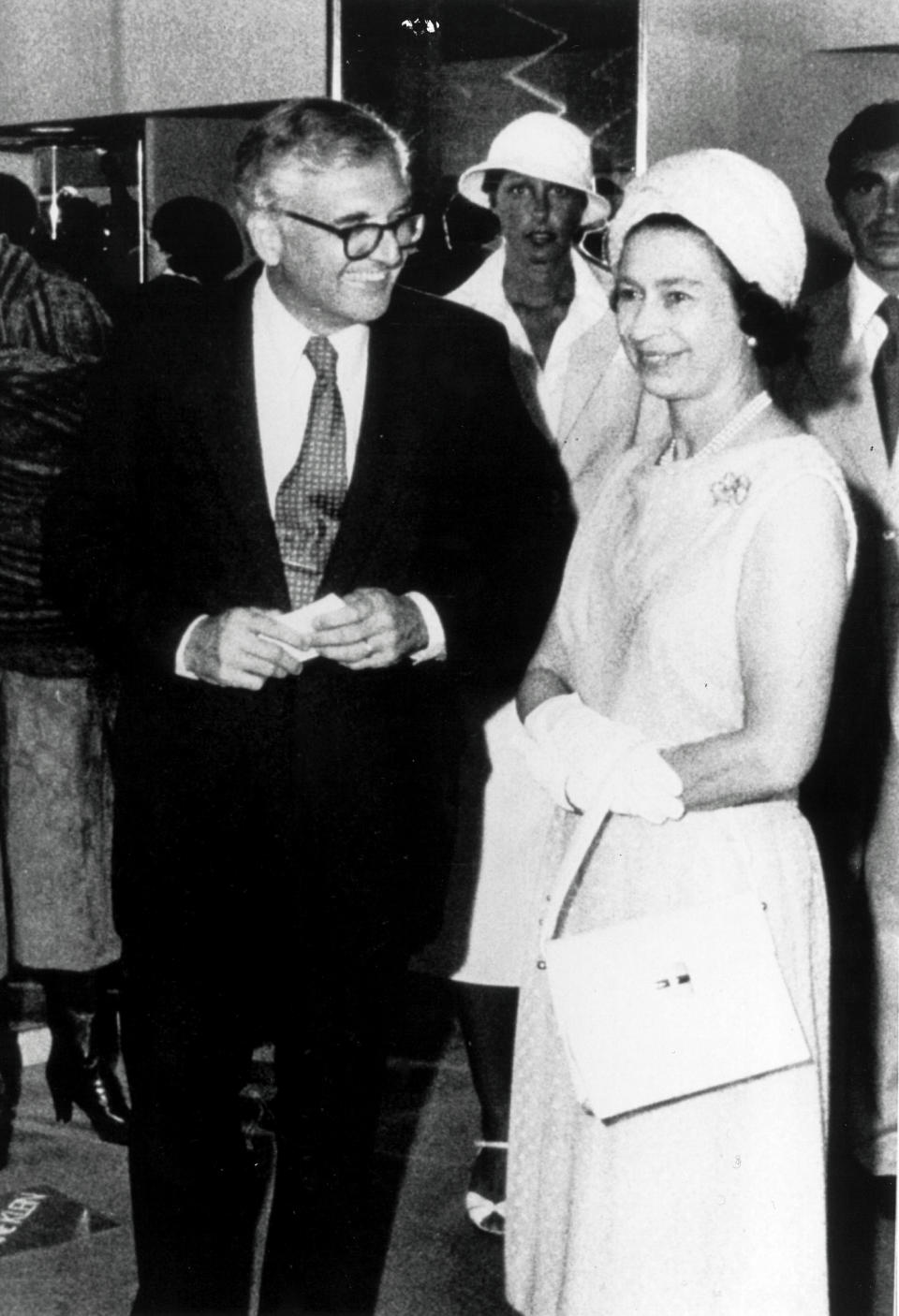
Sept. 9, 1976: Betty Ford is guest of honor at the opening of the Tyson’s Corner, Virginia, store, which duplicates virtually every department in the 59th Street flagship.
1976: To commemorate the flagship’s new lingerie department, Guy Bourdin photographs a “Sighs and Whispers” lingerie catalogue, which becomes controversial and highly collectible.
January 1977: The oldest Bloomingdale’s branch, New Rochelle, New York, closes, hurt by competition from the newer and larger White Plains, New York, branch.
March 1977: Elizabeth Taylor, accompanied by then-husband Sen. John Warner, is guest of honor at the opening of the White Flint Mall branch in Bethesda, Maryland. The store closed in March 2012.
Sept. 14, 1977: Bloomingdale’s holds a Kenzo fashion show at Studio 54. Grace Jones performs.
May 1, 1978: Marvin Traub becomes chairman and chief executive officer, succeeding Lawrence Lachman, who retires.
Spring 1978: After almost a decade, Bloomingdale’s revives the import-fair strategy with “India: The Ultimate Fantasy,” a successful promotion that is extended by two weeks so India’s prime minister Morarji Desai could visit.
July 1978: Woody Allen starts filming “Manhattan” with a scene inside Bloomingdale’s.
Sept. 21, 1978: Yves Saint Laurent’s Opium perfume launches exclusively at Bloomingdale’s with a $100,000 party on an antique junk moored in the South St. Seaport, including guests Andy Warhol, Faye Dunaway, Warren Beatty, Mikhail Baryshnikov, Jacqueline Onassis and Barbara Walters. Sales top $500,000 in three months.

Sept. 26, 1978: Bette Davis models in a “Death on the Nile”-inspired fashion show at Bloomingdale’s.
July 1979: Le Train Bleu, an elegant French restaurant resembling a classic dining car opens on the roof of the flagship.
Nov. 15, 1979: The “B’Way” remodel and expansion of the cosmetics floor, designed by Ann Larkin and Sylvia Pontecorvo under Barbara d’Arcy’s direction, debuts with its signature checkerboard black Belgian and white Carrera marble flooring; 1,500 guests come to the opening party benefiting the Joffrey Ballet.
1980: Bloomingdale’s By Mail catalogue launches, generating $3 million in first-year sales.
May 6, 1980: Bloomingdale’s hosts Thierry Mugler’s first show in America, with models Jerry Hall and Alva Chino on the runway, for 2,500 guests at the Bond’s club in Times Square.
Fall 1980: “Heralding the Dawn of a New Era” import fair devoted to China features a Cantonese farmhouse, a Chinese garden pavilion and 20 exquisite robes from 1763 to 1908 never before seen outside the Forbidden City.
June 1981: Bloomingdale’s opens in the King of Prussia, Pennsylvania, mall, then the largest mall in America.
Aug. 11, 1982: Bloomingdale’s opens in Willow Grove Park Mall in Willow Grove, Pennsylvania.
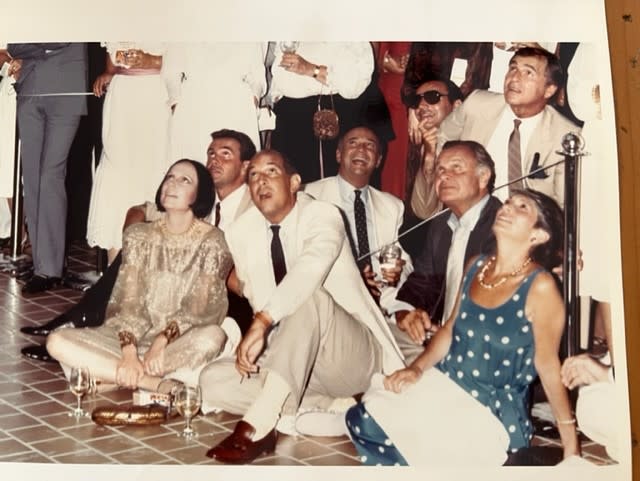
April 14, 1982: “The Philippines” promotion launches with a gala attended by Imelda Marcos. A collection of her state gowns are displayed.
August 1982: Calvin Klein Underwear launches at Bloomingdale’s.
Sept. 13, 1983: “Fête de France” import fair opens with black-tie dinner for 1,650, raising more than $90,000 for the preservation of Claude Monet’s atelier and gardens at Giverny.
Oct. 10, 1983: Bloomingdale’s opens in the Valley View mall in Dallas but the store closes during Federated’s bankruptcy proceedings, extending from 1990 to 1991.
April 6, 1984: The movie “Moscow on the Hudson” starring Robin Williams as a Soviet circus musician who defects in Bloomingdale’s, is released.
Aug. 12, 1984: Bloomingdale’s opens at The Falls in Miami, but the store closes in January 2020.
Nov. 18, 1984: Thousands of fans turn up to see the cast of Dynasty attend a promotion for costume designer Nolan Miller’s collection. Linda Evans, Pamela Bellwood, Gordon Thomson, Jack Coleman, Heather Locklear, Michael Nader and Catherine Oxenberg and the show’s co-creator Esther Shapiro sign autographs and sell Dynasty licensed products.
1986: “The Bloomingdale’s Healthy Diet” by Laura Stern is published, after Marvin Traub and 33 Bloomingdale’s staffers lose more than 500 pounds.
Sept. 10, 1986: “The World of Bloomingdale’s” celebrates 100 years on 59th Street with a party for 1,000 guests raising more than $100,000 for the East Side House Settlement.
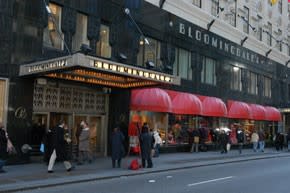
Oct. 29, 1986: Bloomingdale’s opens in the Town Center at Boca Raton mall in Florida, which becomes a top branch.
1987: After a dispute with International Ladies Garment Workers Union, Norma Kamali closes her company and becomes an in-house designer for Bloomingdale’s, developing swimwear, ready-to-wear and hosiery. The partnership ends in 1992.
Sept. 17, 1987: “Mediterranean Odyssey” promotion kicks off showcasing merchandise and foods from Greece, France, Israel, Italy, Morocco, Spain and Turkey, and a Christian Lacroix $15,000 dress, the first Lacroix to arrive in New York after his debut solo collection in Paris.
April 1, 1988: After a 10-week fight, Federated Department Stores agrees to a $6.6 billion takeover by Canadian real estate developer Robert Campeau. At the time, it’s the largest non-oil merger and the largest hostile bid in corporate history.
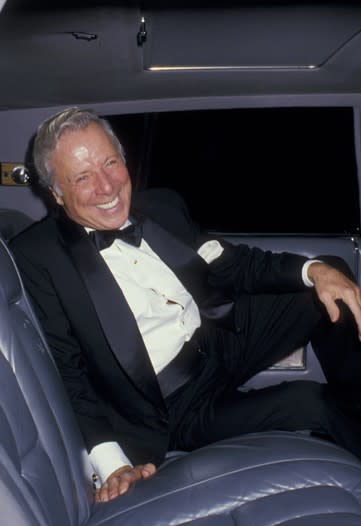
April 5, 1988: “Hooray for Hollywood” celebration opens with a gala benefiting the American Foundation for AIDS Research for 800 guests.
September 1988: Bloomingdale’s opens on Chicago’s North Michigan Avenue with a black-tie gala and a Karl Lagerfeld fashion show for 3,400 guests benefiting the Chicago Symphony.
Jan. 15, 1990: Campeau’s Federated Department Stores and Allied Stores retail conglomerate including Bloomingdale’s, Burdine’s, Abraham & Straus, Lazarus, Rich’s, Goldsmith’s, The Bon Marché, Jordan Marsh, Maas Brothers and Stern’s, files Chapter 11 bankruptcy.
April 8, 1990: “Broadway ’90” promotion features a gala benefiting Broadway Cares, the theater community’s AIDS fundraising organization, and 11 white dresses symbolizing “The Great White Way,” (the nickname for Manhattan’s theater district because of all its bright lights and billboards) created by 11 American designers, and five model rooms inspired by Broadway actors.
1990 to 1991: While restructuring during bankruptcy, Bloomingdale’s closes stores in Dallas, Stamford, Connecticut, and Fresh Meadows, Queens, New York.
1991: Bloomingdale’s By Mail becomes its own company and offers merchandise not found in the stores. The department store continues to produce its own catalogue of goods.
Sept. 11, 1991: “Tempo d’Italia, Bloomingdale’s largest import promotion with $100 million worth of merchandise, opens at all 15 Bloomingdale’s stores. Past promotions usually brought in $30 million.
Nov. 15, 1991: Michael Gould becomes chairman and CEO, succeeding Marvin Traub.
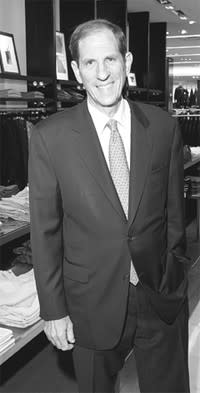
April 12, 1992: “Spirit of America” fair opens, celebrating American fashions and furnishings.
August 1992: Bloomingdale’s opens at the Mall of America in Bloomington, Minnesota, but closes the location in spring 2012.
December 1994: Federated acquires Macy’s, thereby lifting Macy’s out of bankruptcy proceedings after two years.
November 1996: In its biggest and most aggressive expansion, Bloomingdale’s opens its first four stores in California, all within eight days, converted from former Broadway stores in Beverly Center, Century City, Fashion Island and Sherman Oaks.
April 6, 1999: Bloomingdale’s launches Sean John sportswear.
Dec. 21, 1999: Bloomingdale’s renews its lease on the 59th Street flagship until 2056. The property is still owned by members of the Bloomingdale family.
June 2002: Kal Ruttenstein, senior vice president for fashion direction for more than 25 years, guardian of Bloomingdale’s fashion image and responsible for discovering many designers, receives the CFDA’S Eleanor Lambert Award for his longtime contributions to the fashion industry. He celebrates the award and his birthday with a party at the Hudson Penthouse with Marc Jacobs, Ralph Lauren, Karl Lagerfeld and Donna Karan, among others. Ruttenstein passed away in December 2005.
Feb. 6, 2003: Bloomingdale’s opens a home furnishings store in the landmarked Medinah Temple (a former Shriners temple) in Chicago, but the store was closed and sold in 2019.
Oct. 18, 2003: Bloomingdale’s opens branches in Lenox Square and Perimeter Mall in Atlanta, Georgia, following a charity gala benefiting the Atlanta Symphony Orchestra.
April 23, 2004: Bloomingdale’s SoHo opens. At 82,000 square feet, the store presents an edited version of Bloomingdale’s assortment and generates more than $1 million in sales in its first two days.
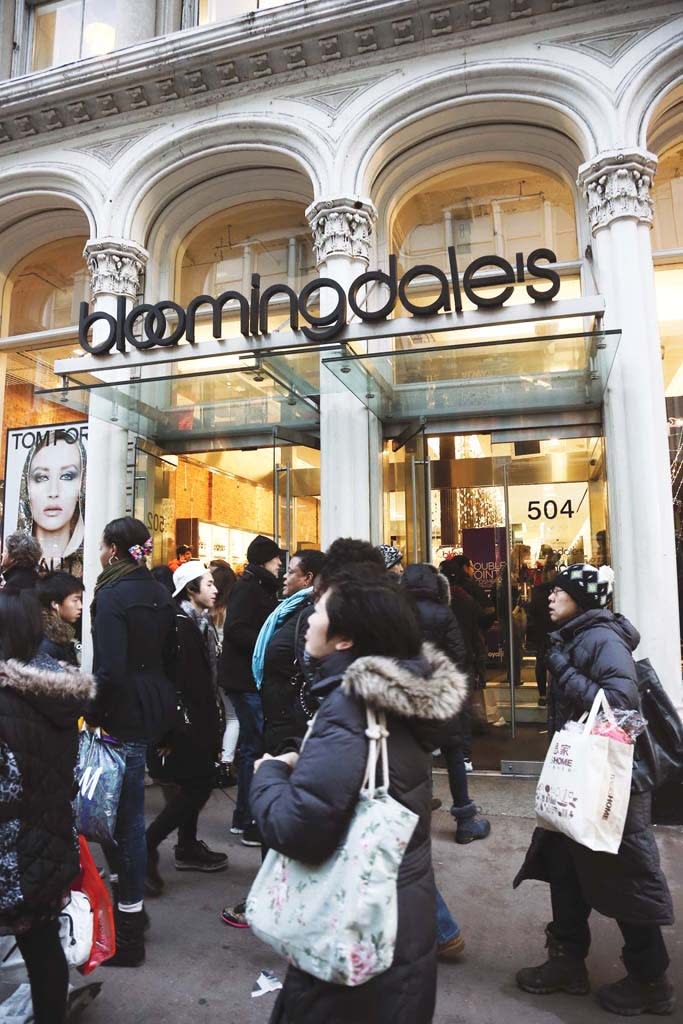
Sept. 28, 2006: Bloomingdale’s opens its second-largest store, a five-floor, 330,000-square-foot unit in the Westfield San Francisco at Union Square.
May 4, 2007: Bloomingdale’s opens in South Coast Plaza, Costa Mesa, California, on the site of a former Robinsons-May department store once part of May Department Stores purchased by Federated in 2005.
June 1, 2007: Federated changes its name to Macy’s Inc. A year earlier, Federated controversially renamed all the department stores in the portfolio mostly to Macy’s, with a few becoming Bloomingdale’s.
May 15, 2008: Bloomingdale’s By Mail catalogue begins phasing out to focus on growing bloomingdales.com. The Bloomingdale’s catalog produced by the department stores continues.
Feb. 1, 2010: Bloomingdale’s opens its first international location in The Dubai Mall through a licensing deal with Al Tayer Group LLC, a United Arab Emirates-based company.
August 2010: Bloomingdale’s opens it first fashion outlet at Potomac Mills in Woodbridge, Virginia; a second opens later in the month in the Bergen Town Center in Paramus, New Jersey.
Aug. 6, 2010: Bloomingdale’s opens in the Santa Monica Place center, but closes the site in March 2021.
Summer 2011: Bloomingdale’s opens a Magnolia Bakery in the flagship.
November 2013: Bloomingdale’s open in Glendale, California.
February 2014: After 23 years at the helm, Michael Gould steps down as chairman and CEO, and is succeeded by his protege Tony Spring, who started and has spent his entire career at Bloomingdale’s.
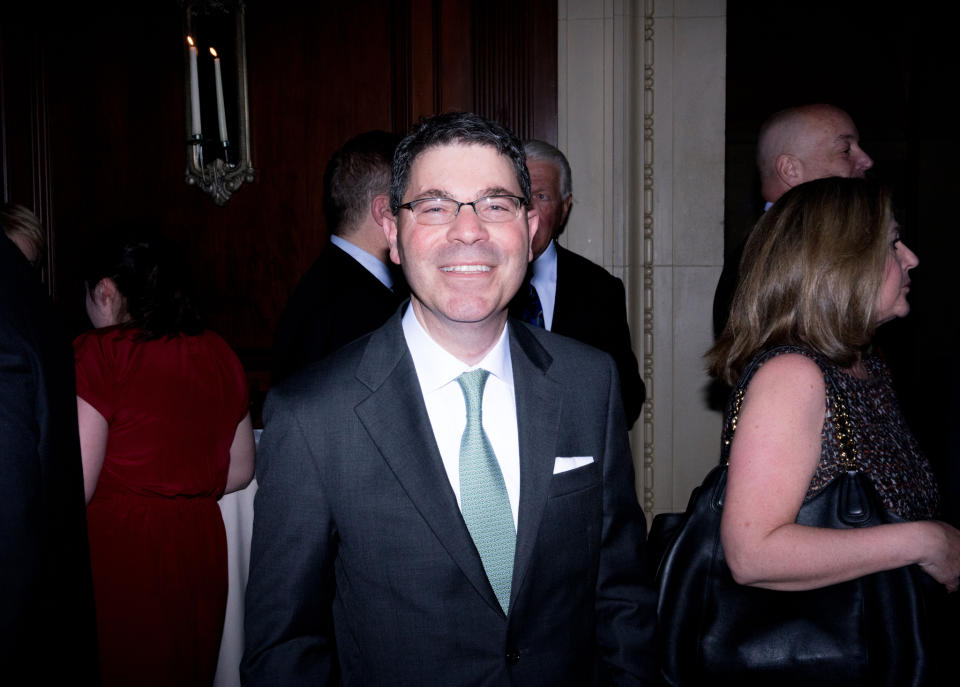
Sept. 17, 2015: Sarah Jessica Parker launches her SJP Collection shoes at Bloomingdale’s, the first New York store to carry the line.
Nov. 12, 2015: Bloomingdale’s opens its first store in Hawaii, in Honolulu’s Ala Moana mall, the world’s largest open-air shopping mall.
Dec. 28, 2016: Le Train Bleu closes after 37 years.
March 9, 2017: Bloomingdale’s in Kuwait opens at the 360 Mall through the licensing deal with Al Tayer Group.
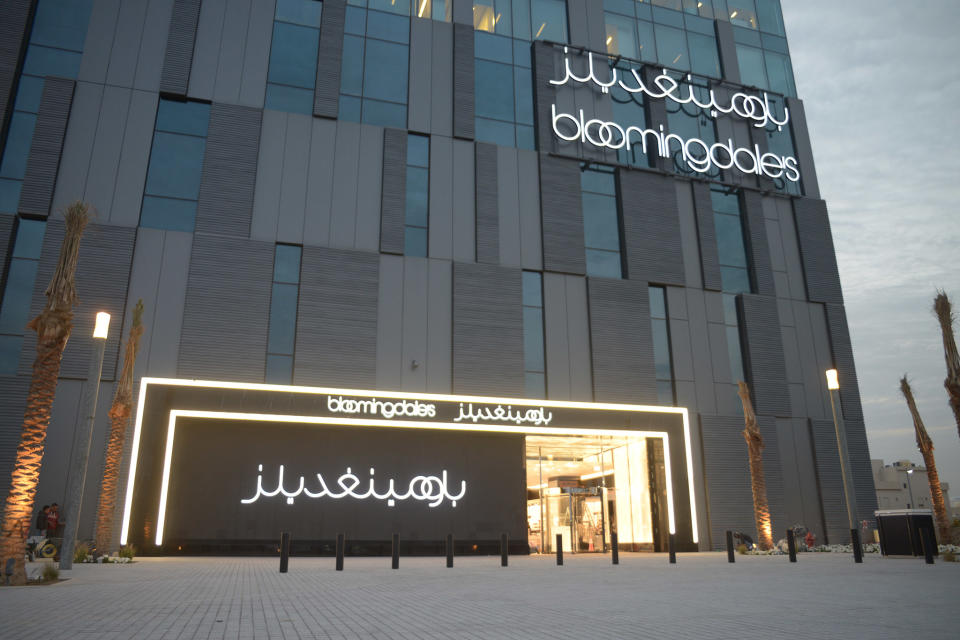
April 5, 2018: Bloomingdale’s launches a “reimagined” footwear floor occupying 26,763 square feet and stocking more than 100 brands.
Sept. 20, 2018: A revamped denim floor opens on the second floor of the flagship.
Jan. 17, 2019: Bloomingdales’s launches its revamped cosmetics floor, with more than 36,000 square feet and an additional 1,100 square feet of beauty outposts on other floors.
March 19, 2019: Bloomingdale’s launches its revamped contemporary, advanced contemporary and designer floors on levels two, three and four of the flagship encompassing 128,900 square feet.
Sept. 21, 2019: To celebrate the 25 anniversary of “Friends,” Bloomingdale’s recreates Central Perk, the show’s famous coffee shop; Rachel’s Bloomingdale’s office where she was a personal shopper for a while, and there’s a curation of Ralph Lauren designs reflecting Rachel’s style on the show when she worked at Ralph Lauren.
October 2019: Macy’s and Bloomingdale’s announce they will stop selling fur by February 2021.
Nov. 22, 2019: John Legend performs at the unveiling of Bloomingdale’s Christmas windows.

Aug. 26, 2021: “Bloomie’s,” a 22,000-square-foot scaled-down version of Bloomingdale’s launches in the Mosaic District shopping center in Fairfax, Virginia.
December 2021: Bloomingdale’s launches a new 13,000-square-foot men’s shoe area.
Sept. 9, 2022: Bloomingdale’s officially launches its 150th anniversary celebration, with special events, shops, marketing and merchandise to continue throughout the year.
Sign up for WWD's Newsletter. For the latest news, follow us on Twitter, Facebook, and Instagram.
RSVP for "A Matter of Style", a Fairchild Archive exhibition September 9-10 in New York City.